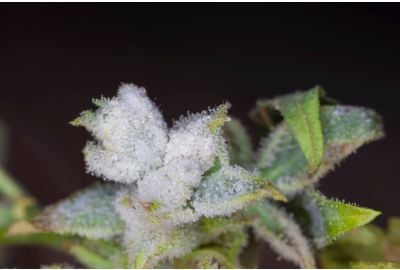How To Get Rid Of Powdery Mildew On Cannabis
Powdery mildew on cannabis, otherwise known as WPM, is a common and fast-spreading pathogen hungry for your marijuana. Although its snow-like appearance can turn your grow room into a winter wonderland, the fungal disease is definitely on Santa's naughty list.
According to commercial and home growers with experience of powdery mildew on weed, it's one of the most common and often challenging cannabis 'pests' to control. Unlike similar fungi found on weed plants like botrytis (bud rot), you can't eradicate WMP by simply drying out the environment.
To prevent and get rid of powdery mildew, you must arm yourself with an in-depth knowledge of appropriate and effective treatment methods. Then it's time to attack the situation from as many different angles as possible to get one step ahead of the fungus.
Learn how to do all this and more as we put powdery mildew on marijuana under the microscope. We'll take a closer look at what exactly WMP is, how it damages weed plants, and what you can do to avoid it ruining your harvest.
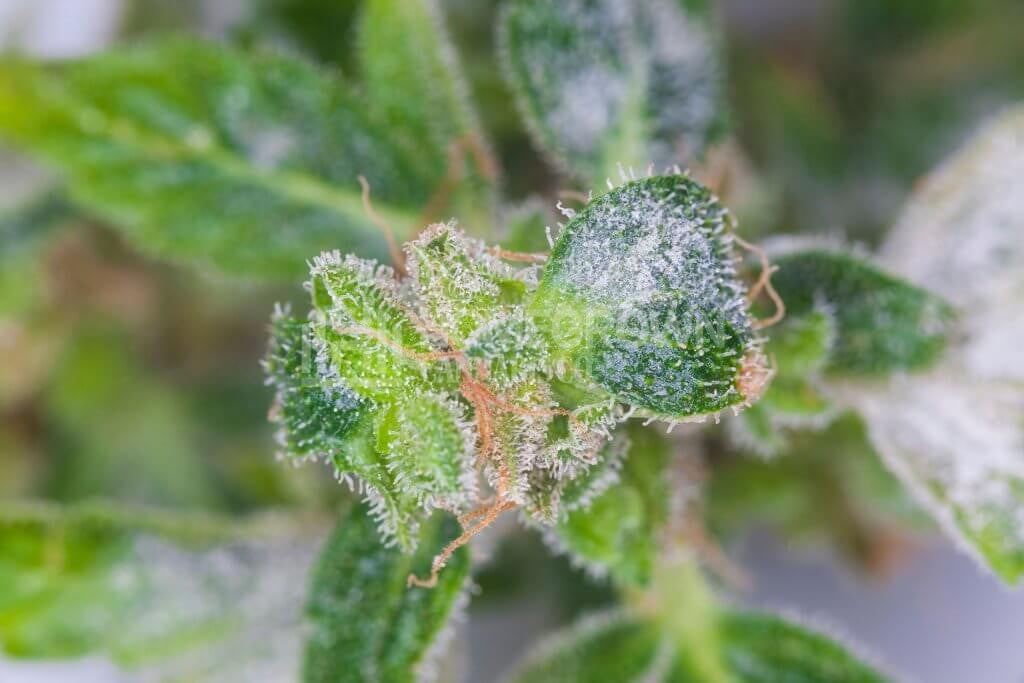
What is powdery mildew?
WPM is one of the most common problems a marijuana cultivator can encounter throughout their growing journey. The fungal disease attacks the plant's foliage, sucking the life out of its cells and inhibiting its ability to photosynthesize.
Cannabis powdery mildew spores can lay dormant for long periods waiting for a suitable host to latch onto. They don't need standing water, only spells of high humidity to germinate. Once the spores find a home, the fungus spreads fast, leaving behind a trail of damage and signs of illness within three days of infection.
Like any other living thing, it aims to eat and reproduce. In its favor, white powdery mildew on cannabis can propagate sexually and asexually.
The good news is WPM isn't the master of disguise. With regular monitoring of your crop, it's easy to spot before it causes long-term health complications. In the early stages, it's also simple to treat and won't necessarily pose a risk to your final yield.
What does powdery mildew look like
Powdery mildew on cannabis plants has a unique appearance, and once you learn what to look out for, misdiagnosis is almost impossible. The clue is in the funguses given name—symptoms begin with what looks like white powder on cannabis leaves.
As the powdery mildew on cannabis spreads, it leaves behind white fluffy circular patches similar to dustings of flour over the leaves. Before long, the severity of the case increases, and grey-colored blotches appear. The infected surface area keeps extending until it takes over the entire plant, including the buds.
Early intervention is the most effective way to stop cannabis powdery mildew in its tracks. While monitoring your crop for signs of infection, look for:
- Leaves with a light dusting of white powder similar in appearance to flour.
- Circular white spots of fuzz over leaves, stems, and flowers
- Once healthy leaves quickly turn yellow, wither, and dry out until they fall off.
- New or young growth may break, twist, or become deformed.
- Buds may also develop disfigured and in less abundance.
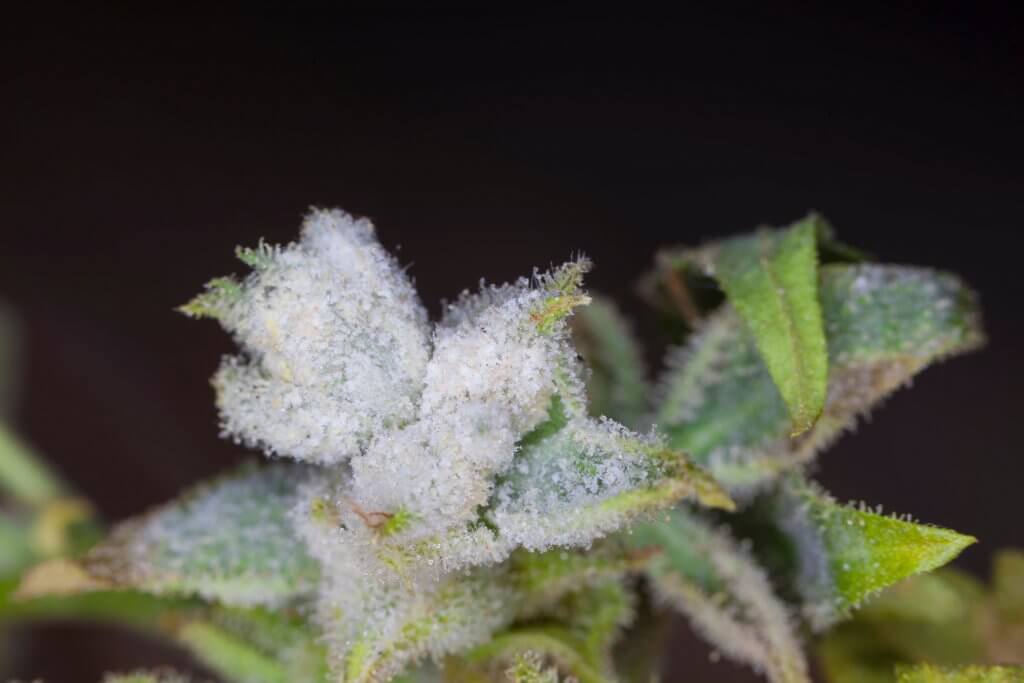
Is powdery mildew harmful to marijuana?
Powdery mildew on marijuana plants can spread fast and spoil entire crops in less than a week if left untreated. The airborne pathogen not only ruins the appearance of your weed but also inhibits the plant's ability to photosynthesize. As a result, your cannabis suffers from a chain reaction of processing issues leading to detrimental health complications.
Seedlings and young plants are most at risk of fatality from WPM. At this life cycle stage, plants are more susceptible to disease and need every drop of energy created from photosynthesis to grow healthy.
Powdery mildew, while cannabis is flowering, is bad news for your crop. Not only are your treatment options reduced so as not to risk the quality or safety of your nugs, but the fungus stunts flower growth.
With this said, white powdery mildew on cannabis buds is a bigger nightmare. Deep within the dense nugs of your crop, WMP can fester discreetly, rendering them useless for consumption. Infected nugs pose a serious danger to your health if you smoke them. Research states you'll be at a higher risk of lung disease and respiratory infections.
What causes powdery mildew on cannabis
WPM spores are primarily airborne and can enter your grow space, whether indoors or out, in various ways. However, you can unknowingly contaminate your crop when touching your plants with your hands or clothes—even your pets can carry spores on their fur.
Once the spores are on your weed, what causes powdery mildew on cannabis are the right conditions for them to germinate, thrive, and take over. The below environmental factors are to blame for triggering an infestation of powdery mildew on cannabis:
- High humidity - Most cannabis strains love humid environments, especially seedlings and rooting clones. At this stage, they require levels of around 65–80%, while vegetating weed prefers a relative humidity of around 40–70%. WPM also thrives in these conditions, so make sure you keep an eye out.
- Lack of airflow - A lack of air movement in your grow space is to blame for letting spores settle in the first place. A fan is an invaluable tool that deters numerous pest types by making it impossible for things to land on your cannabis.
- Poor ventilation - Proper ventilation of your grow area provides multiple benefits to your weed. Replacing stale air with fresh air isn't only important for photosynthesis; it also filters out threats like WPM spores before they get a chance to latch on.
- Overcrowding - Leaf-on-leaf contact forms moisture, which makes your plant more susceptible to mildew and mold. When cannabis crops touch each other, they also create a handy bridge for pests and diseases to spread rapidly.
Signs of powdery mildew on weed
If you notice your plant's leaves beginning to pimple and blister on the surface, that's a tell-tale sign that the fungus is creeping over your crop. Once these appear, the covering of white powder won't be far behind. Spotting this early calling card gives you a good head start on implementing powdery mildew cannabis treatment.
Another clear indication that WPM has infiltrated your crop is the smell of decaying vegetation. Closely examine all your plants and their buds. The fungus is bound to be hiding somewhere if the stench of death is in the air.
How to get rid of powdery mildew on cannabis plants?
Learning how to get rid of powdery mildew on cannabis is a skill every cultivator should grasp before starting their growing journey. Use our guide below to discover what you need to do to save your weed at different phases of the cannabis life cycle.
How to get rid of powdery mildew during flowering
WMP is especially prevalent during the flowering stage. The change in relative humidity and extra moisture from increased watering creates the perfect habitat for the fungus. There's also a higher chance that your plants will be touching due to their large size.
An infestation at this point can be detrimental to your final yield leaving many growers in a panic about how to get rid of powdery mildew during flowering.
You should attack the problem head-on with organic treatment methods, which are safe to use up until two weeks before harvesting. Take the time to move your plants to ensure they have plenty of space to spread out. You should also consider bumping up the airflow in your grow area with extra fans to reduce excess moisture.
How to remove powdery mildew from buds
Sadly those searching for remedies on how to remove powdery mildew from buds won't find the answers they're praying for. Once WPM finds its way onto your cannabis flowers, don't waste your time trying to clip it off the buds — they're most likely harboring more than the eye can see and need immediate disposal.
There’s no way of removing WPM on cannabis buds. Powdery mildew on nugs is devastating for all your time and effort, highlighting how important prevention is.
Meticulously check every single bud in your crop for signs of white powdery mildew and remove any sickly ones. You should repeat this process regularly until harvest. Infected buds left on the plant can contribute to the fungus spreading and eventually rot, triggering other cannabis health issues.
Powdery mildew cannabis treatment
The good news is powdery mildew treatment for cannabis methods are plentiful, inexpensive, and simple to apply. You don't have to opt for chemical treatments either; there are numerous organic ways to get rid of powdery mildew.
Before you go ahead with powdery mildew cannabis treatment, you must remove and dispose of any heavily affected foliage. As you do this, take care not to stir up your plants too much as you can easily send spores back into the air. When you've finished, don't compost the clipped leaves, or you'll contaminate your peat.
After pruning, turn your focus to the salvageable foliage. Wet a cloth with water or your chosen WPM remedy and gently wipe off any remaining signs of the disease. During the process, spores cling to the damp material, so ensure your cloth doesn't touch any unaffected areas of the plant.
You should then spray your crop down with your chosen commercial product or DIY solution to kill off any remaining fungi and prevent further attacks. Below we've compiled some of the best powdery mildew cannabis treatment mixtures you can make at home.
Baking soda for powdery mildew on cannabis
Using baking soda for powdery mildew on cannabis is one of the most popular choices among home cultivators. In a spray bottle, mix two tbsp of baking soda with one gallon of water or two tbsp with one gallon of water and ½ tsp of liquid hand soap.
Apply the solution once a week to make your plants uninhabitable for the fungus to survive. WPM prefers a neutral pH balance of around 7.0, whereas this baking soda remedy turns the environment alkaline.
Neem oil for powdery mildew on weed
Neem oil is essential to have in your growing area. It can prevent and kill almost any pest that comes knocking, including powdery mildew on weed. When applied during the early onset of the fungus, it gets to work by killing the spores giving WPM no chance to latch on.
To make your own neem oil spray, mix five tsp per one gallon of water. Mist your plants once every week to prevent fungi from calling your weed home.
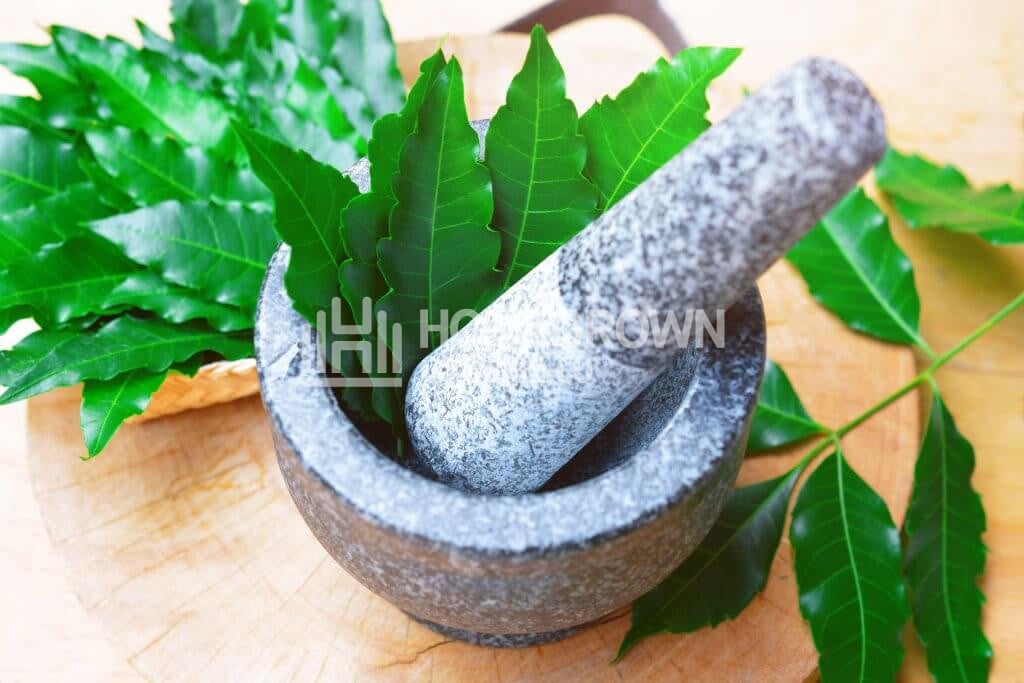
Milk for white powdery mildew on cannabis
Much research has gone into how to treat powdery mildew on cannabis organically. One of the most interesting discoveries is the effectiveness of milk.
Giving your weed a milk shower twice a week has proven to prevent WPM and help rid it from your grow space in the early stages. To use milk on your crop, dilute 6 parts water with 4 parts milk.
Hydrogen peroxide for powdery mildew on cannabis plants
Another solution seasoned growers wouldn't be without while cultivating weed is hydrogen peroxide and water mixture. Combining one tsp per gallon of water gives you a powerful weapon against powdery mildew on cannabis.
While hydrogen peroxide is an organic treatment method, it’s much harsher on your plants, and you should only apply it when necessary.
Apple cider vinegar for white powdery mildew on weed
Apple cider vinegar solutions are an old and trusted favorite amongst cultivators. Dropping up to three tbsp of vinegar into a gallon of water does the opposite to baking soda. This technique creates a highly acidic environment WPM can't survive in.
For effective preventative and speedy treatment, spray your plants with the solution every three days.
Potassium bicarbonate for WPM
Potassium bicarbonate is another must-have in your arsenal against WPM. It kills powdery mildew on cannabis and fungus spores as soon as it touches them.
To make your DIY solution, all you need to do is dissolve one tbsp of potassium bicarbonate with one gallon of water. For an extra kick of potency, add ½ tsp of liquid soap. Regular application every one to two weeks helps keep WPM at bay.
Baking soda for powdery mildew on cannabis is the remedy of choice for growers facing a mild fungus infestation. However, when WPM takes hold, it's best to turn to potassium bicarbonate.
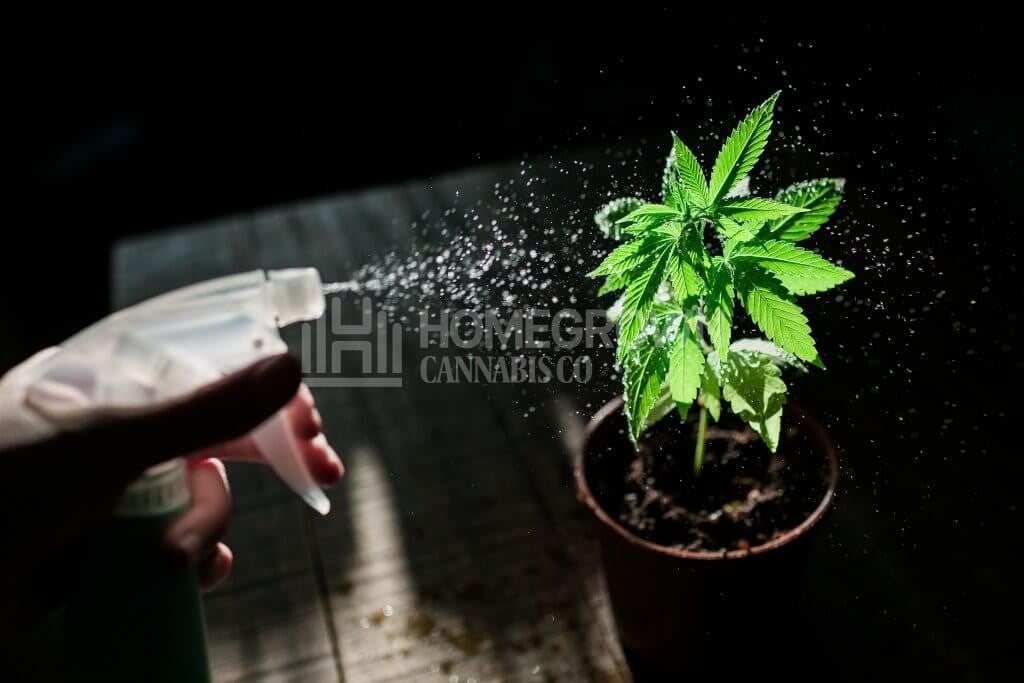
How to avoid powdery mildew on weed plants
Fending off WPM is relatively easy and needs no fancy gadgets. The same preemptive measures are also useful in deterring other cannabis health problems. Read on to learn how to avoid powdery mildew.
- Opt for mildew-resistant or tolerant strains - There are many marijuana strains on the market nowadays that are mildew-resistant or tolerant, thanks to their genetics. Cultivating one of these gives you a solid head start in avoiding powdery mildew on cannabis.
- Secure air circulation and ventilation - Placing oscillating fans around your grow room keeps air moving and prevents fungus spores from landing on your weed. They also assist in drying out any excess moisture.
Meanwhile, good ventilation filters out the spores left in the air and controls humidity levels in the space. Creating the perfect balance between air circulation and ventilation creates an unfavorable environment for WPM.
- Fine-tune heat and humidity - Marijuana thrives when heat and humidity sit within the right parameters. Unfortunately, the fungus loves the same levels your pot does. However, the range in which WPM can withstand is much smaller than cannabis.
They both revel in temperatures between 60 and 72. Pushing the heat to 74 won't impede your plant's health but stops white powdery mildew on cannabis in its tracks. The same goes for humidity, WPM thrives best when it's high, but most cannabis strains can grow healthy at the lower end of the scale.
- Avoid overcrowding - Never fill your grow space and remember to prune your weed regularly. Abiding by these rules promotes better airflow and faster drying. It also reduces the chances of pathogens spreading between neighboring crops.
- Water carefully - Lower the risks associated with a build-up of moisture in your grow space by avoiding overhead systems and only watering your weed during daylight hours. At night, moisture in the air thickens, and less evaporation occurs. You should also shake off any excess water sitting on your plant from condensation or rain.
- Use fungicides - Routine application of liquid foliar formulas makes the environment inhospitable for powdery mildew on marijuana plants to survive. Add one or more of these organic sprays into your cannabis care schedule to prevent WPM and other pests from day one.
- Examine your weed - Even if you have a fully automated system, you should get up close with your cannabis daily and monitor for changes or signs of stress. Use a jeweler's loupe or magnifying glass to inspect your buds for WPM.
What to do if you have powdery mildew on buds after harvest
Powdery mildew on buds after harvest is a cultivator's worst nightmare. The blight is one of the largest concerns for commercial growers and a top cause of entire yield destruction. While home cultivators may not feel the same financial slap in the face, the heartache is just as painful.
While you may have already picked and destroyed the infected flowers before harvest, there’s also a high chance an infected nug has slipped through the net. White powdery mildew on a bud can contaminate and spread to all other flowers it comes into contact with, making them only fit for the trashcan.
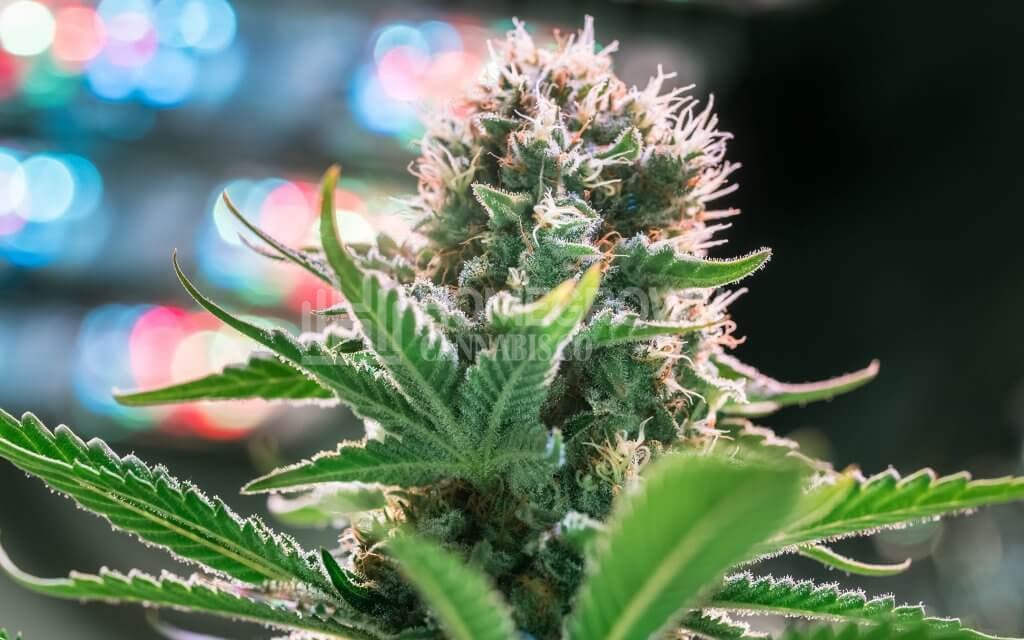
Wave goodbye to white powdery mildew on weed
Powdery mildew on cannabis is a minor illness that can rapidly turn into a major loss if left to wreak havoc on your weed. Prevent the threat altogether by making your grow space uninhabitable for the fungus.
Use this guide to create your toolbox of DIY cannabis powdery mildew remedies that work as a preventative and a cure if applied early enough. Following our advice means you won't have to worry about the disaster that’s powdery mildew on weed nugs.
Now you've learned how to get rid of powdery mildew on cannabis plants; it's time to master other skills surrounding home cultivation. Take a look at our blog for all things marijuana.
About the author: Parker Curtis
Parker Curtis has around a decade of cannabis-growing experience, specialising in soil-less and hydro grows. He’s mastering outdoor, greenhouse, and indoor grows.
